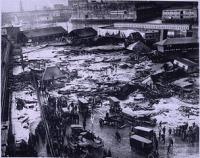 We recently posted about a serious molasses spill in Honolulu harbor which has killed 26,000 fish and may have longer term consequences for the harbor ecology. Rick Austin was kind enough to forward an article about a far larger and more deadly molasses spill, the Great Boston Molasses Flood of 1919.
We recently posted about a serious molasses spill in Honolulu harbor which has killed 26,000 fish and may have longer term consequences for the harbor ecology. Rick Austin was kind enough to forward an article about a far larger and more deadly molasses spill, the Great Boston Molasses Flood of 1919.
On January 15, 1919, in the North End neighborhood of Boston, Massachusetts, a large molasses storage tank burst, sending a 7.5 meter high and 50 meter wide wave of molasses surging through the streets at an estimated speed of 35 mph (56 km/h). The tank flooded the streets with an estimated 2,300,000 US gallons of molasses, or roughly ten times the size of the spill that has done so much damage in Honolulu. The Boston molasses flood killed 21 and injured 150. As reported by Scientific American: The deluge crushed freight cars, tore Engine 31 firehouse from its foundation and, when it reached an elevated railway on Atlantic Avenue, nearly lifted a train right off the tracks. A chest-deep river of molasses stretched from the base of the tank about 90 meters into the streets. From there, it thinned out into a coating one half to one meter deep. People, horses and dogs caught in the mess struggled to escape, only sinking further.
To understand why a wave of molasses could do so much damage requires some science. Scientific American explains: A wave of molasses does not behave like a wave of water. Molasses is a non-Newtonian fluid, which means that its viscosity depends on the forces applied to it, as measured by shear rate. Consider non-Newtonian fluids such as toothpaste, ketchup and whipped cream. In a stationary bottle, these fluids are thick and goopy and do not shift much if you tilt the container this way and that. When you squeeze or smack the bottle, however, applying stress and increasing the shear rate, the fluids suddenly flow. Because of this physical property, a wave of molasses is even more devastating than a typical tsunami. In 1919 the dense wall of syrup surging from its collapsed tank initially moved fast enough to sweep people up and demolish buildings, only to settle into a more gelatinous state that kept people trapped.
Stephen Puleo has written a history of the disaster: a Dark Tide: The Great Boston Molasses Flood of 1919.
